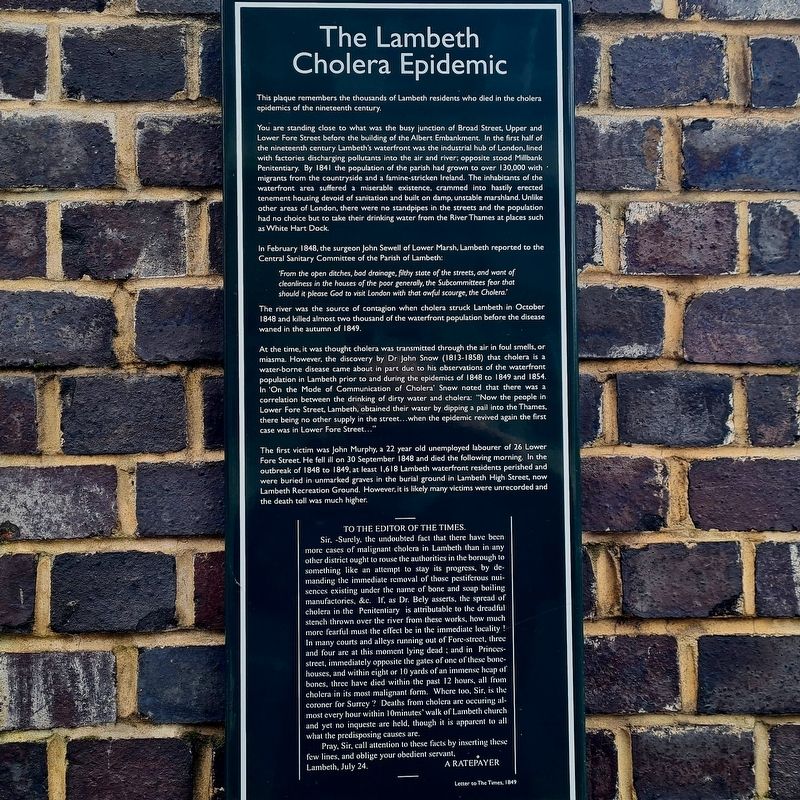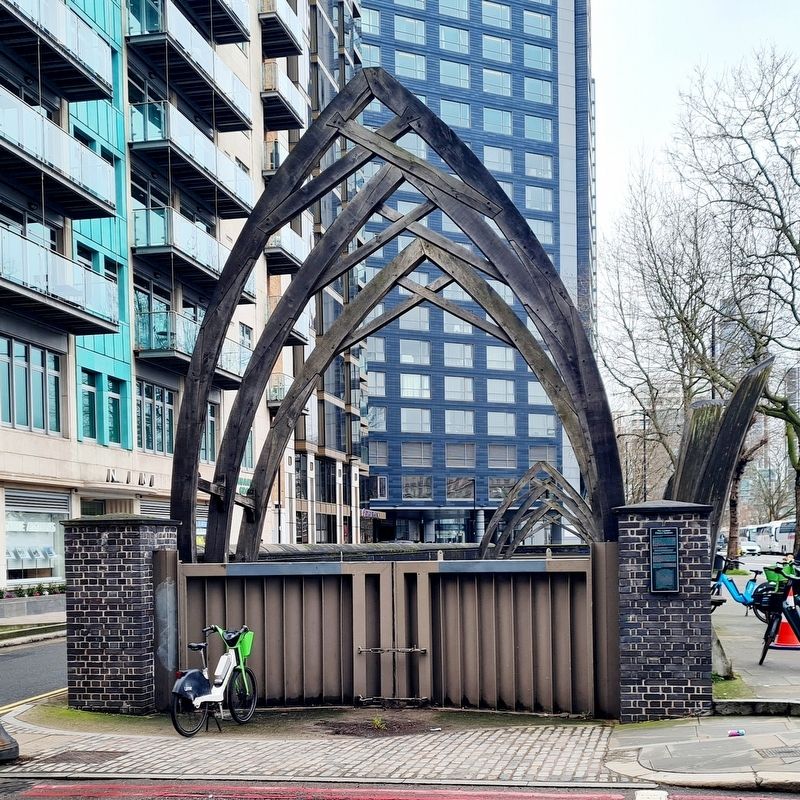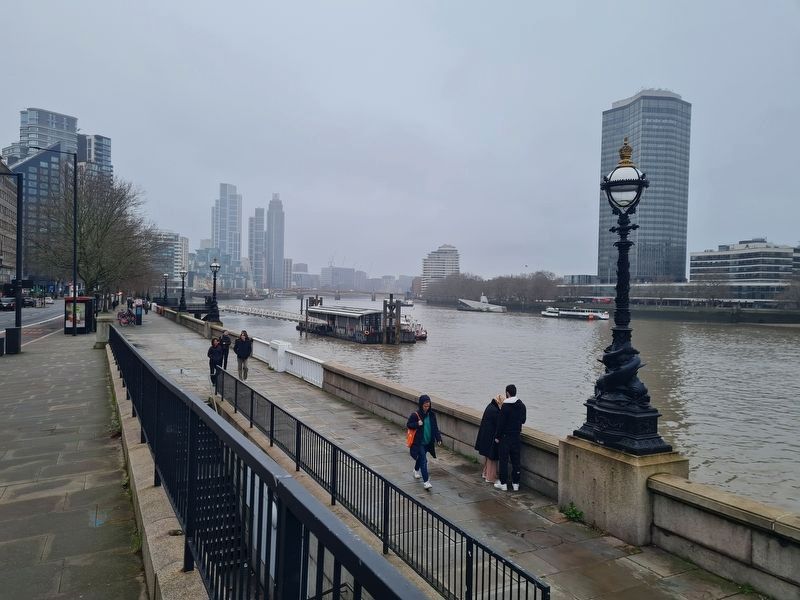Vauxhall in Lambeth in Greater London, England, United Kingdom — Northwestern Europe (the British Isles)
The Lambeth Cholera Epidemic
This plaque remembers the thousands of Lambeth residents who died in the cholera epidemics of the nineteenth century.
You are standing close to what was the busy junction of Broad Street, Upper and Lower Fore Street before the building of the Albert Embankment. In the first half of the nineteenth century Lambeth's waterfront was the industrial hub of London, lined with factories discharging pollutants into the air and river; opposite stood Millbank Penitentiary. By 1841 the population of the parish had grown to over 130,000 with migrants from the countryside and a famine-stricken Ireland. The inhabitants of the waterfront area suffered a miserable existence, crammed into hastily erected tenement housing devoid of sanitation and built on damp, unstable marshland. Unlike other areas of London, there were no standpipes in the streets and the population had no choice but to take their drinking water from the River Thames at places such as White Hart Dock.
In February 1848, the surgeon John Sewell of Lower Marsh, Lambeth reported to the Central Sanitary Committee of the Parish of Lambeth:
'From the open ditches, bad drainage, filthy state of the streets, and want of cleanliness in the houses of the poor generally, the Subcommittees fear that should it please God to visit London with that awful scourge, the Cholera.'
The river was the source of contagion when cholera struck Lambeth in October 1848 and killed almost two thousand of the waterfront population before the disease waned in the autumn of 1849.
At the time, it was thought cholera was transmitted through the air in foul smells, or miasma. However, the discovery by Dr John Snow (1813-1858) that cholera is a water-borne disease came about in part due to his observations of the waterfront population in Lambeth prior to and during the epidemics of 1848 to 1849 and 1854. In 'On the Mode of Communication of Cholera' Snow noted that there was a correlation between the drinking of dirty water and cholera: "Now the people in Lower Fore Street, Lambeth, obtained their water by dipping a pail into the Thames, there being no other supply in the street...when the epidemic revived again the first case was in Lower Fore Street..."
The first victim was John Murphy, a 22 year old unemployed labourer of 26 Lower Fore Street. He fell ill on 30 September 1848 and died the following morning. In the outbreak of 1848 to 1849, at least 1,618 Lambeth waterfront residents perished and were buried in unmarked graves in the burial ground in Lambeth High Street, now Lambeth Recreation Ground. However, it is likely many victims were unrecorded and the death toll was much higher.
To The Editor Of The Times
Sir, Surely, the undoubted fact that there have been more cases of malignant cholera in Lambeth than in any other district ought to rouse the authorities in the borough to something like an attempt to stay its progress, by demanding the immediate removal of those pestiferous nuisences existing under the name of bone and soap boiling manufactories, &c. If, as Dr. Bely asserts, the spread of cholera in the Penitentiary is attributable to the dreadful stench thrown over the river from these works, how much more fearful must the effect be in the immediate locality! In many courts and alleys running out of Fore-street, three and four are at this moment lying dead; and in Princes street, immediately opposite the gates of one of these bonehouses, and within eight or 10 yards of an immense heap of bones, three have died within the past 12 hours, all from cholera in its most malignant form. Where too, Sir, is the coroner for Surrey? Deaths from cholera are occuring almost every hour within 10 minutes' walk of Lambeth church and yet no inqueste are held, though it is apparent to all what the predisposing causes are.
Pray, Sir, call attention to these facts by inserting these few lines, and oblige your obedient servant, Lambeth, July 24.
A RATEPAYER
Letter to The Times, 1849
Topics. This historical marker is listed in these topic lists: Disasters • Science & Medicine. A significant historical year for this entry is 1848.
Location. 51° 29.538′ N, 0° 7.292′ W. Marker is in Lambeth, England, in Greater London. It is in Vauxhall. Marker is on Albert Embankment, on the left when traveling south. Touch for map. Marker is at or near this postal address: 09 Albert Embankment, Lambeth, England SE1 7AP, United Kingdom. Touch for directions.
Other nearby markers. At least 8 other markers are within walking distance of this marker. White Hart Dock (here, next to this marker); The Special Operations Executive (approx. 0.4 kilometers away); The Buxton Memorial (approx. half a kilometer away); Sir Thomas Peirson Frank (approx. half a kilometer away); W.T. Stead (approx. 0.6 kilometers away); The Burghers of Calais (approx. 0.6 kilometers away); Sir John Gielgud (approx. 0.7 kilometers away); Emmeline Pankhurst (approx. 0.7 kilometers away). Touch for a list and map of all markers in Lambeth.
Related marker. Click here for another marker that is related to this marker.
Credits. This page was last revised on February 17, 2024. It was originally submitted on February 17, 2024, by Stephen Palmer of Ascot, England. This page has been viewed 41 times since then. Photos: 1, 2, 3. submitted on February 17, 2024, by Stephen Palmer of Ascot, England. • Andrew Ruppenstein was the editor who published this page.


